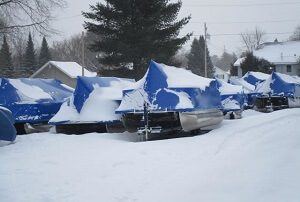Cost to Winterize a Boat
Last Updated on December 18, 2022
Written by CPA Alec Pow | Content Reviewed by ![]() CFA Alexander Popinker
CFA Alexander Popinker
With the arrival of winter, it is not only car drivers who have to worry about preparing their cars for the cold season. Boat owners pay a lot more for winterization, whether they leave their boats in the water or take them ashore. Before you buy a boat, you have to consider that it is a lot of work and you will have to take around $1,000 out of your pocket for the maintenance of the boat in the cold season, the costs varying from one boat to another.
How much does it cost to winterize a boat?
The cost of winterizing a boat is affected by several factors, the most notable being the place where you are living, the professional you hire, the services included in the winterization, the type of boat you own, and the type of engine it has. For example, the cost of winterization for a boat that is less than 40 feet would be anywhere between $420 and $750, without including shrink wrapping or any extra storage. This is the average price regardless of whether you hire a marina, a dealer, or a private mechanic.
If you want to hire Thayer’s Marine for winterizing your boat, you should be prepared to spend anywhere between $300 and $400, depending on the horsepower. According to their official website, an outboard winterization includes the anti-corrosion spray, a flush, the fuel separator change, a fog change, a prop grease, a fuel conditioning change, and an oil change.
In case you are living in Tennessee, you can hire Sportman’s Boat Storage to prepare your boat for winter. If you only need to winterize the boat and not change the oil, you will have to pay around $230. On the other hand, if you want both servicing and winterizing your inboard-outboard boat, you will have to get around $290 out of your pocket.
What are the additional expenses?
The shrink wrapping is a must if you want to store your boat outside during the winter. Unfortunately, this service is not included in the winterization costs. So, you will have to pay another $10 to $20 or more per foot.
You might also like our articles on the cost of boat rewiring, fiberglass boat repair, or boat upholstery repair.
Depending on how far the boat has to travel, pickup and delivery fees can add hundreds of dollars. In general, the companies will charge a flat rate which is anywhere between $130 and $220, plus another $8+ per mile to travel and $10+ per foot to haul.
Another cost to take into consideration is the fee for storing your boat inside of a temperature-controlled facility. The costs per season would be anywhere between $1,550 and $2,600.
How to prepare a boat for the winter season?
The underwater part of the boat must be cleaned, sanded, and repainted with anti-fouling paint before each season. Also, any repairs must be done before entering the cold season.
The deck of the boat must be checked before winter, to detect any cracks in the gel coat, detached railings, or loose cleats. All these repairs are done ahead of time before the boat is kept out of service for several months during the cold season.
 It must also be cleaned and washed with special products for the nautical field and not with cleaning products made for home or car. The latter can attack the materials of the boat. If it is necessary to paint the boat, it is done before it is stored for the winter, with nautical paint that protects the boat from UV rays or possible scratches that may occur.
It must also be cleaned and washed with special products for the nautical field and not with cleaning products made for home or car. The latter can attack the materials of the boat. If it is necessary to paint the boat, it is done before it is stored for the winter, with nautical paint that protects the boat from UV rays or possible scratches that may occur.
The boat’s electrical equipment and the engine should be checked by a marine specialist. The navigation lights and battery contacts, along with all the wiring and technical details that make the boat work perfectly in full season must be checked.
The interior of the boat should be kept dry and ventilated. Windows and hatches must remain closed and secured, and if possible dry ventilation can be fitted to the entire vessel. The refrigerator should be cleaned, emptied, and left with the door open for ventilation.The same will be done to the entire water installation, including waste water tanks, potable water, and drain traps. Don’t forget all the textiles on the boat either. Make sure they are tightly packed and stored in a dry place.
Last but not least, checking safety equipment is a priority. Each component must be examined and you will also have to check the expiration and overhaul dates of the raft and lifejackets.
All of these things can help keep your boat safe in the cold season so it can be used again in the heat of the summer season.
Why boats or other watercraft should not be left uncovered or unpreserved during winter?
Boats left uncovered or unpreserved over the winter can be damaged, even completely destroyed in the cold season. Component materials such as gelcoat, upholstery, or dashboard instruments can be affected by cold temperatures if they are not kept in optimal conditions. Improper storage in closed and unheated sheds can lead to increased mite and mold build-up on all boat components, which can be nearly impossible to repair in the spring/summer.


Leave a Reply
Want to join the discussion?Feel free to contribute!